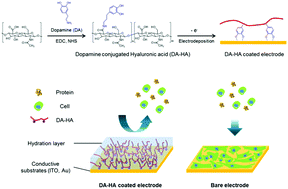Electrochemical deposition of dopamine–hyaluronic acid conjugates for anti-biofouling bioelectrodes†
Abstract
Bioelectrodes have been widely used to effectively mediate electrical signals with biological systems for various biomedical applications, such as biosensors and prosthetic probes. However, the electrical properties of bioelectrodes are frequently degraded in the biological milieu due to biofouling of bioelectrode surfaces. Hence, the development of simple and effective strategies for bioelectrode surface modification is important for the mitigation of biofouling. To this end, we electrochemically modify electrodes with dopamine-conjugated hyaluronic acid (DA–HA); the modified electrodes exhibit highly hydrophilic surfaces. In addition, the electrochemical impedance of the DA–HA-modified electrodes remains similar to those of bare electrodes. The DA–HA-modified electrodes showed reduced non-specific protein adsorption and minimal adhesion of fibroblasts. Our novel electrochemical passivation of electrodes using DA–HA will contribute to the further development of fouling-resistant and biocompatible bioelectrodes. The electrodeposition of DA–HA can also be potentially applied for general surface modification of other metallic and conducting materials for various applications.

- This article is part of the themed collection: Journal of Materials Chemistry B Emerging Investigators


 Please wait while we load your content...
Please wait while we load your content...